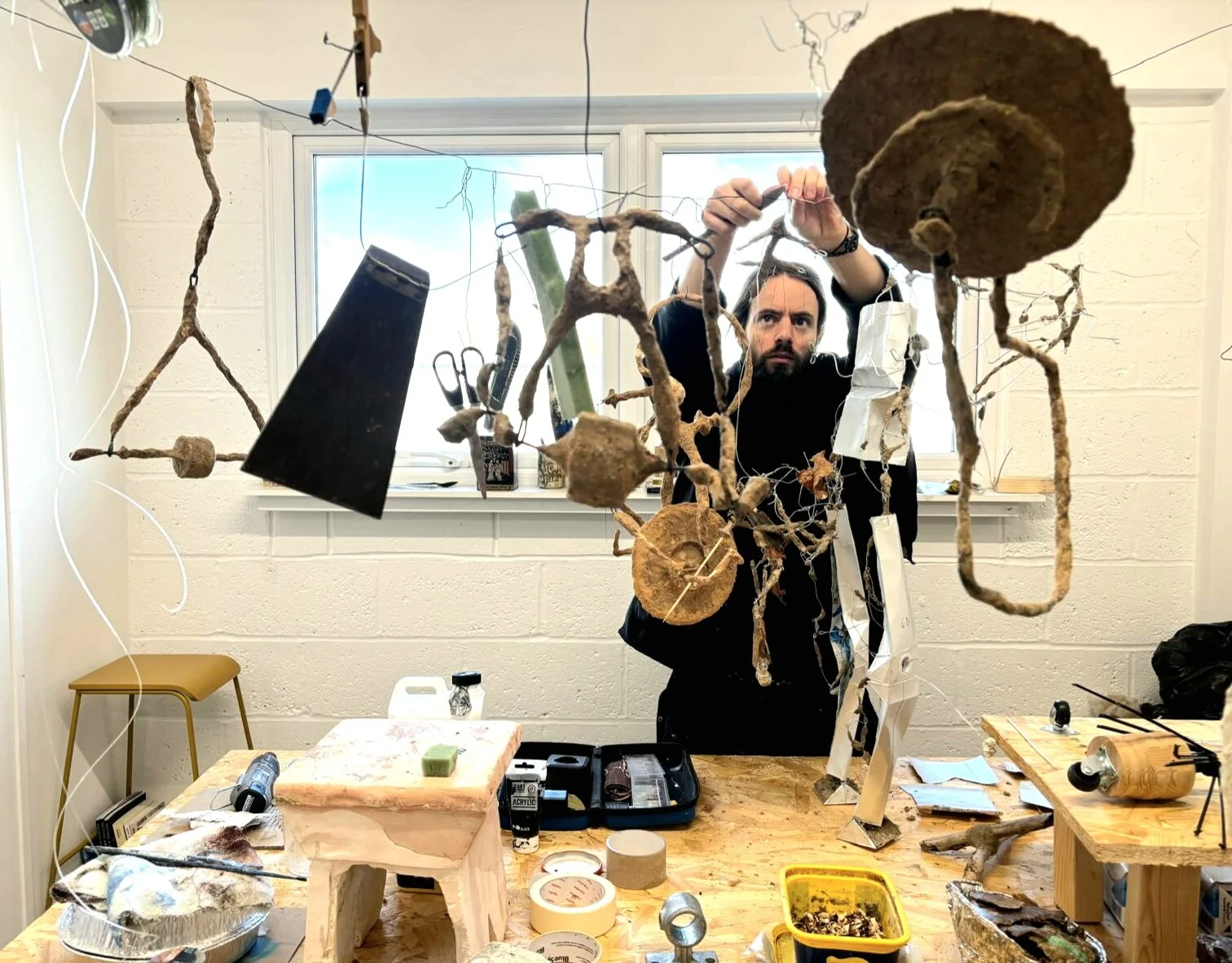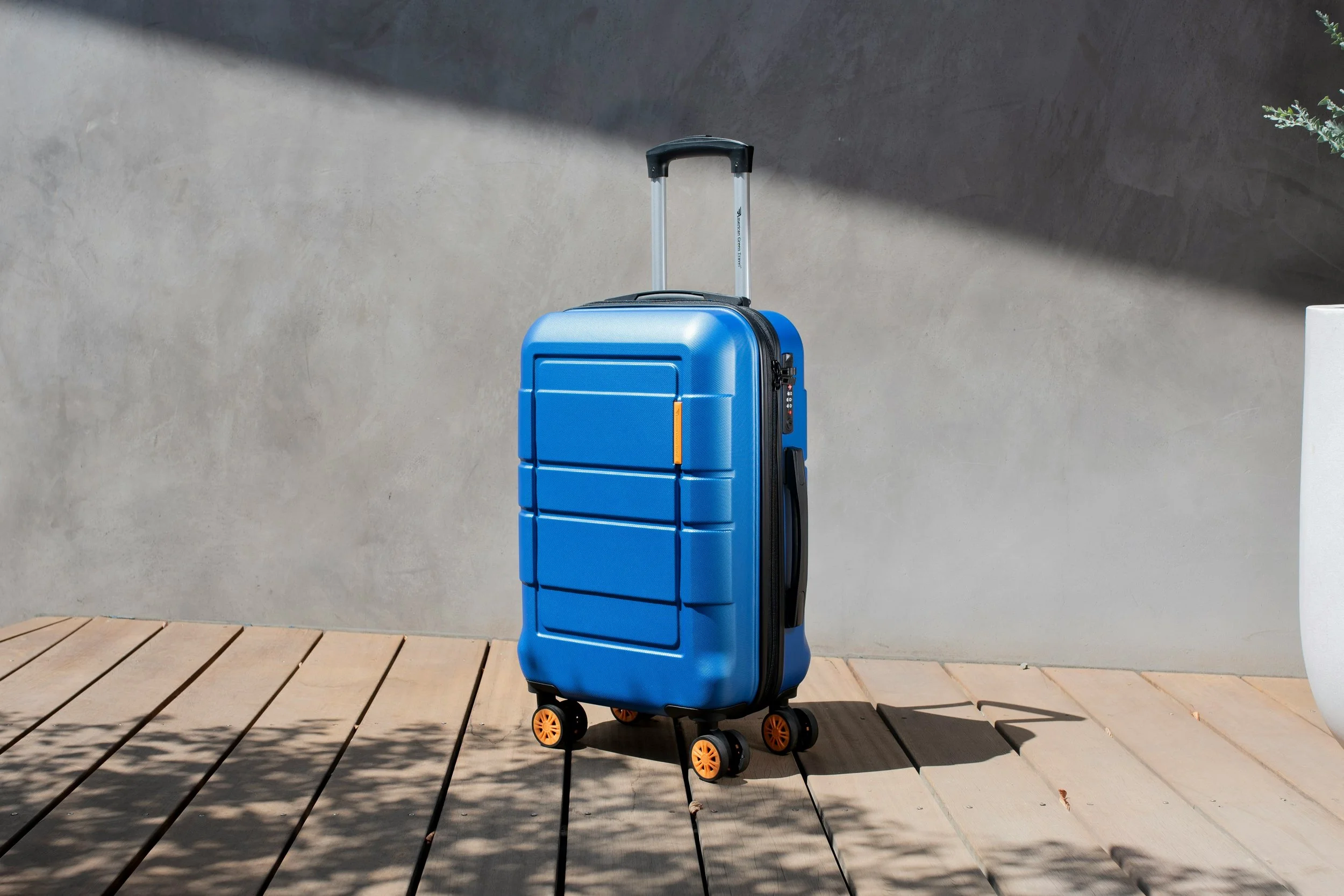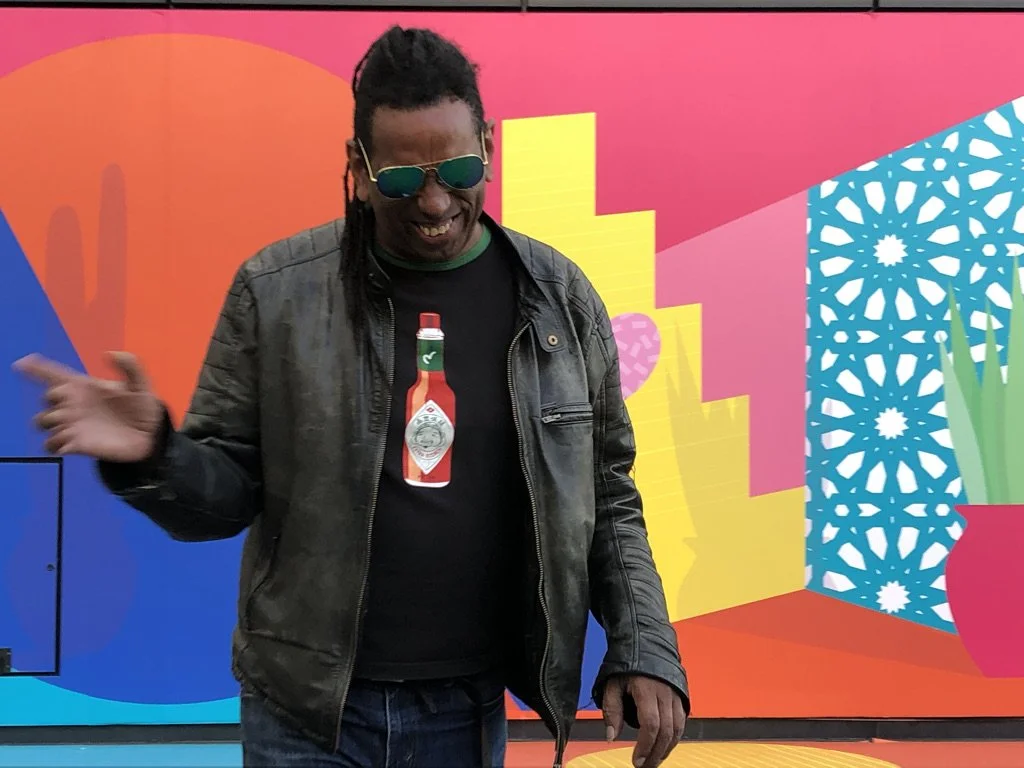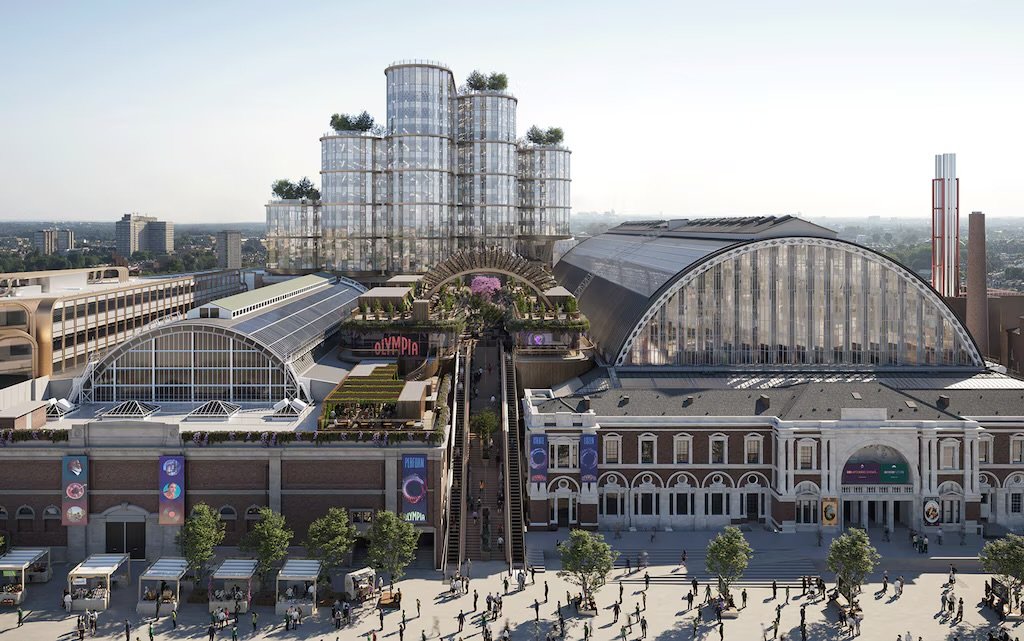In conversation with Iona Scott
“In an effort to convey the importance of these creatures I put them in as many public facing places as possible…”
- Iona Scott

Image: Iona Scott with a Discosphaera Plankton Light Sculpture.
Iona Scott is a rare breed – a multimedia artist, her creativity spans technology, science and art, and her works are seen in diverse locations, as often in aquariums and scientific institutions as in galleries and festivals.
She is well known for her Plankton Light Sculptures, originally inspired by the Discosphaera Tubifera, a type of single-celled marine micro plant – or phytoplankton. The works aim to stimulate a closer connection with the incredible tiny lifeforms, invisible to the human eye and yet responsible for producing approximately 50% of the oxygen on our planet. Through visual and sensory experiences, she also hopes to raise awareness about the importance of phytoplankton, using the plankton light sculptures and also immersive films and animations that together create a seamless and mesmerising journey from our world, through the threshold into the submarine realm.
As an artist she fuses elements of art and technology through exhibitions and collaborations in a variety of locations. Recently, her work has been shown at Make Hauser and Wirth Somerset, as part of an installation of work by her mother Rachel Scott, Soho House’s Brighton Beach House, The Royal Botanical Gardens at Kew, Micropia Museum at ARTIS Amsterdam Royal Zoo and Brighton Science Festival – as well as Glastonbury Festival and Burning Man. It has been on show in Pimlico underground in London as part of Art Below, and several sculptures are now on permanent display at The Deep Aquarium in Hull.
How did you begin your journey into art? Did you grow up in a creative environment?
Yes, my family is creative but also, I was encouraged at school as I could draw and paint realistically. Everyone in my family has a very different type of artistic or creative skill and I think all of them have had a big effect on me. It’s so inspiring to see the work ethic of my parents (Rachel Scott and Frank Bowling) and to learn from them and be constantly exposed to their example throughout our lives together. To witness the consistency of both of their artistic practices is an honour and I feel very grateful and privileged to be part of their journey and to be included, supported and encouraged by them.
At what point did the subject of micro plankton become so central to your practice?
When I was studying for my degree in fine art/sculpture I was looking for subject matter. The Head of Sculpture at Norwich School of Art where I did my Fine Art Degree was an avid scuba diver and gave slide shows of the underwater world – I was very drawn to the shapes and colours of that world. In one of his books about the Great Barrier Reef, I came across an image of a Discosphaera tubifera which is a type of microscopic marine phytoplankton and I was immediately drawn to its shape. For my Degree Show I set about recreating it as a 6ft sculpture and suspended it centrally to fill a same-sized space and painted the walls with some of the vibrant tropical colours of the underwater world. Over the following years exhibiting my sculpture, I started to discover the significance of marine phytoplankton in producing approximately half the oxygen on the planet and how little this was represented in aquariums and museums. So, I started to expand on this aspect in my work by making 3D animations to make this invisible world visible and to look for places who were interested in exploring this further.

Image: Installation view from Iona Scott’s Degree Show at Norwich School of Art, Norwich, UK
What do you hope will be the effect of your Plankton Light Sculptures on those who see them?
I hope people will be surprised, excited and intrigued enough to experience the immersive aspect of my work. Perhaps they might feel more connected to nature and be curious to find out more about these incredible creatures.
And can you tell us a bit about your animations and the immersive elements in your work? What do you hope people gain from those works?
Since I completed my MA in Computer Animation and Digital Special Effects in 1998, I have been experimenting with film making, 2D animation, stereoscopic 3D animation, VR, room sized projections and projection mapping as a means to transport my audience to a total sensory experience of the otherwise invisible microscopic submarine dimension and meet the vitally important micro plants that inhabit in this space. I hope people will feel that they have had a new and positive experience that encourages them to feel reconnected on a deeper level to the natural world all around them, and are reminded that they are part of nature and from that place feel more empowered to make decisions taking that essential fact into account.

Image: Iona Scott’s Discosphaera, Radiolaria and Asterionella Plankton Light Sculptures installed at Micropia
You often place your sculptures and animations in unexpected places and situations. What excites you most about doing this?
The element of surprise and incongruity. My work is primarily visual, and I love the concept of magnifying these tiny geometric forms from another unseen dimension and enlarging and inserting them into the familiar scale of our world. In an effort to convey the importance of these creatures I put them in as many public facing places as possible and so the location and context of my artwork is ever changing. I see it as introducing a bizarre visual glitch in our otherwise predictable existence to interrupt our routine and hopefully bring some fun and uplift. I believe that art is for everyone and ideally invites us to notice art everywhere.
And a quick fire 5:
Any upcoming projects of note that you can discuss?
This year, I have a Discosphaera Plankton Light Sculpture in the Arts and Causes 2023 Charity Art Auction and I am creating visuals for a Tribal Energy event in October. Also, in November my works will be heading to Malta for the Mdina Biennale of Contemporary Art. I am very excited about all of these projects.
What have been the most rewarding moments of your career thus far?
Some of the most rewarding moments so far were being commissioned by The Royal Botanical Gardens at Kew to create a stereoscopic 3D animation 'Swimming with Phytoplankton in 3D' in 2004 which was on permanent display until 2017. Also, when Micropia Museum, part of ARTIS Royal Amsterdam Zoo, purchased a discosphaera plankton light sculpture and commissioned me to make two new designs of phytoplankton 3D printed light sculptures in 2019 for the Amsterdam Festival of Light. And the permanent exhibit of my plankton light sculptures and animation ‘Deepsea Discosphaera’ which were installed at The Deep aquarium in Hull this year. I am really so grateful for all the opportunities to exhibit my work.

Image:Iona Scott’s projection-mapping works at Lightform Lab at the Old Market, Brighton, UK
What’s the best advice you have ever received?
The four agreements: Don’t take anything personally, always do your best, be impeccable with your word, don’t make assumptions.
Who are you outside of the ‘office’?
I've recently been told I'm an undercover rocker.
What do you love about London?
The anonymity, the Tube, the river, the history, the buildings, the scale, the plethora of events and opportunities to meet new people and see and be part of amazing things, the hustle and bustle, and the multiculturalism of my hometown London.
Website: discosphaera.com
Instagram: @discosphaera
Judith Clark is a curator and fashion exhibition-maker, and currently Professor of Fashion and Museology at the University of the Arts London. She lectures on the MA Fashion Curation and is a founding Director of the Centre for Fashion Curation. From 1997 to 2002, she ran London’s first experimental fashion gallery in Notting Hill…
Lindokuhle Sobekwa is a South African photographer from Katlehong, Johannesburg. Since his first exhibition in 2013, his work on social issues and personal histories—like his photo essay Nyaope—has gained international recognition. A member of Magnum Photos, Sobekwa was recently awarded the 2025 Deutsche Börse Photography Foundation Prize for his project I carry Her Photo with Me…
Sol Bailey Barker is a multidisciplinary artist whose work explores the connections between ecology, mythology, and speculative futures. Through sculpture, sound, and installations, they blend ancient knowledge with emerging technologies to examine humanity’s relationship with the natural world…
Hanna Salomonsson is a London based Swedish ceramic artist. Following a career in landscape architecture, she re-trained in ceramics in 2018. She also holds a BA in Art History, and this combined with her landscape grounding provides a unique vantage point for her ceramic practice…
Lewis Walker is a London-born queer, non-binary movement artist. A former Great Britain gymnast and Acrobatic Gymnastics World Champion, they trained from age 6 to 21 before earning a degree in Contemporary Dance. Their work spans theatre, film, fashion, music, and the commercial sector. Walker continues to choreograph gymnastics competition routines for the Great Britain, Italian and French national teams…
Daniel is a curator-producer dedicated to the social impact of the arts and cross-sector collaboration. He is currently Creative Director & Chief Executive of Old Diorama Arts Centre (ODAC) in Euston, where he has strengthened the centre’s community connections amidst urban transformation…
Peter Bellerby is the founder of Bellerby & Co. Globemakers, a company renowned for its exquisite hand-crafted globes. Established in 2010, the company specialises in meticulously designed pieces that showcase exceptional craftsmanship, positioning Bellerby & Co. as a leader in the globe-making industry…
Gabriele Beveridge is known for her sculptural and conceptual practice that combines materials as diverse as hand-blown glass, photo chemicals, and found images…
Robyn Orlin is a South African dancer and choreographer born in Johannesburg. Nicknamed in South Africa "a permanent irritation", she is well known for reflecting the difficult and complex realities in her country. Robyn integrates different media into her work (text, video, plastic arts) to she investigates a certain theatrical reality which has enabled her to find her unique choreographic vocabulary…
Katrina Palmer, an artist known for exploring materiality, absence, and dislocation, recently spoke to us following her year-long residency at the National Gallery about her exhibition The Touch Report…
Enej Gala is an artist who splits his time primarily between London and his hometown of Nova Gorica, Slovenia. A graduate of the Academy of Fine Arts in Venice and the Royal Academy Schools (2023), Gala first gained our attention with Neighbour’s Harvest, an installation that cleverly combined puppetry and conceptual art…
David Ottone is a Founding Member of Award-winning Spanish theatre company Yllana and has been the Artistic Director of the company since 1991. David has created and directed many theatrical productions which have been seen by more than two million spectators across 44 countries…
Darren Appiagyei is a London-based woodturner whose practice embraces the intrinsic beauty of wood, including its knots, cracks, bark, and grain. Highly inspired by Ghanaian wood carving, Darren explores raw textures and new woods in his work…
Huimin Zhang is an artist specialising in 22K gold, known for her innovative craftsmanship. She combines various cultural techniques, including filigree, engraving, and European gold and silver thread embroidery, to create unique works…
Akinola Davies Jr. is a BAFTA-nominated British-Nigerian filmmaker, artist, and storyteller whose work explores identity, community, and cultural heritage. Straddling both West Africa and the UK, his films examine the impact of colonial history while championing indigenous narratives. As part of the global diaspora, he seeks to highlight the often overlooked stories of Black life across these two worlds.
Hannah Drakeford is a London-based interior designer known for her bold and colourful interiors. She transitioned from a 21-year retail design career to interior design, and has gained popularity on social media where she now shares creative upcycling tutorials and encourages individuality in home decor…
Shula Carter is an East London-based creative with a background in contemporary, ballet, and modern dance. She trained at the Vestry School of Dance and later at LMA London, where she developed skills in commercial, hip hop, and tap dance, alongside stage and screen performance…
Dian Joy is a British-Nigerian interdisciplinary artist whose work delves into the intersections of identity, digital culture, and the fluid boundaries between truth and fiction. Her practice is rooted in examining how narratives evolve and shape perceptions, particularly in the digital age.
Dian Joy is a British-Nigerian interdisciplinary artist whose work delves into the intersections of identity, digital culture, and the fluid boundaries between truth and fiction. Her practice is rooted in examining how narratives evolve and shape perceptions, particularly in the digital age.
John-Paul Pryor is a prominent figure in London’s creative scene, known for his work as an arts writer, creative director, editor, and songwriter for the acclaimed art-rock band The Sirens of Titan…
Jim Murray is an actor, director, conservationist and artist known for Masters of Air (2024) and The Crown (2016). Murray first came to prominence as an artist in 2023 with his acclaimed inaugural exhibition In Flow, where his dynamic abstract paintings were hung in conversation with John Constable’s The Dark Sid…
Anthony Daley is an abstract expressionist painter known for his vibrant, large-scale works that explore beauty through intense colour and light. His art bridges the past and present, drawing inspiration from the Old Masters as well as diverse sources like literature, science, poetry, and nature.
Rachel Kneebone’s work explores the relationship between the body and states of being such as movement, stasis, and renewal. Through her porcelain sculptures, she examines transformation and metamorphosis, reflecting on what it means to inhabit the body and be alive…
Saff Williams is the Curatorial Director at Brookfield Properties, bringing over fifteen years of experience in the arts sector…
Sam Borkson and Arturo Sandoval III, the acclaimed LA-based artists behind the renowned collective "FriendsWithYou," are the creative minds behind "Little Cloud World," now on display in Covent Garden. During their recent visit to London, we had the privilege of speaking with them about their creative process and the inspiration behind this captivating project.
Kinnari Saraiya is a London-based Indian artist, curator, and researcher whose work focuses on trans-altern and post-humanist ideas from the Global South. She is currently a curator at Somerset House and has held positions at the Baltic Centre for Contemporary Art, Frieze Art Fair, and Bowes Museum....
Fusing her Asian roots with a fascination for African pattern work and her deep passion for architectural geometry, Halima’s work is intense yet playful, structured yet creative; substantial yet dynamic and invariably compelling in its originality.
Matilda Liu is an independent curator and collector based in London, with a collection focusing on Chinese contemporary art in conversation with international emerging artists. Having curated exhibitions for various contemporary art galleries and organisations, she is now launching her own curatorial initiative, Meeting Point Projects.
EKLEIDO, a choreographic duo formed by Hannah Ekholm and Faye Stoeser, choreograph performances for live shows and film.

Planning a quick weekend escape from London is a perfect way to recharge and break free from the hustle and bustle of city life. Whether you’re heading to the coast, countryside, or a charming nearby town, having the right things packed ensures your trip runs smoothly and stress-free…
Clive Lyttle is the Artistic Director of Certain Blacks, a new Arts Council England funded organisation. He has held senior roles at Arts Council England, including Head of Combined Arts for the South East, overseeing circus, outdoor arts, and major venues like The Roundhouse and Jacksons Lane…
You might feel like your business is doing well. Profits are steady, and invoices are paid. But what happens if revenue dips next month? Can your business still manage wages, vendor payments, and routine costs?
The Italian Greyhound sits handsomely on the corner of Seymour Street and Seymour Place in an area sprinkled with high end restaurants like Anglo Thai and Basque restaurant Donosita. It is just here to be the neighbourhood restaurant we all need.
Departing from the usual art fair model of booths, Art Basel Qatar will focus on solo exhibitions by galleries, shaped by individual artistic visions. The fair is designed to create a more meaningful experience for visitors while spotlighting artists and galleries from the Middle East, North Africa, South Asia, and beyond…
With the summer holidays underway, there are plenty of brilliant things to do with kids across London. Here’s our guide to seven great activities to do with kids in London this summer…
For our August guide, we’re highlighting some of the exhibitions opening in London this month, as well as the many excellent shows coming to a close…
To mark its 25th anniversary as one of London’s leading cultural institutions, Somerset House will throw open its doors on 13 and 14 September 2025 for Step Inside 25, a celebratory weekend of free interactive events, performances, exhibitions and workshops…
This week in London, experience the timeless ballet Giselle performed by the National Ballet of Japan and a powerful live show where poet Caleb Femi and musician Jordan Stephens blend words and beats. Explore experimental sound at Signals, groove to jazz at JAZZ RE:FEST 2025, and enjoy the orchestral magic of the BBC Proms…
Noreen, a newly opened Middle Eastern restaurant in St Christopher’s Place, offers a standout dining experience with bold flavours and beautifully presented dishes. Surrounded by the charm of cobbled streets, it’s a place worth seeking out…
UTS presents a direct challenge to how the sport defines excellence, demands performance, and connects with those watching. It stands on the brink of becoming something far more influential than a passing novelty…
Kew Gardens has announced the upcoming launch of the Carbon Garden, a groundbreaking permanent installation opening in July 2025. Located within London’s iconic UNESCO World Heritage Site…
A highlight of London’s cultural calendar, Barbican Outdoor Cinema returns this August with an unforgettable programme of open-air film screenings set against the dramatic backdrop of the Barbican Sculpture Court. This year’s edition features a mix of classic favourites, cult hits and recent releases…
Following the success of its landmark tenth anniversary, Photo London is poised to embark on a transformative new chapter in 2026 by relocating to the historic National Hall at Olympia, Kensington. ..




















































